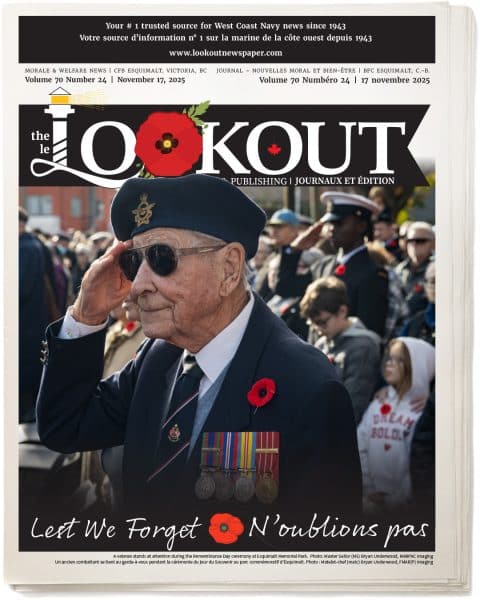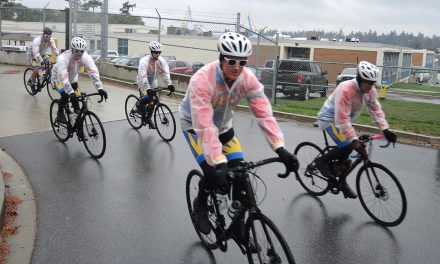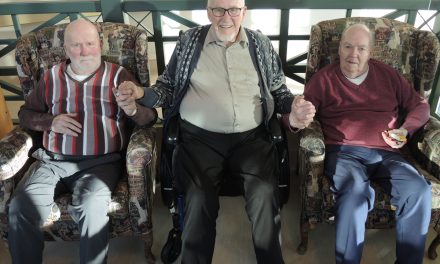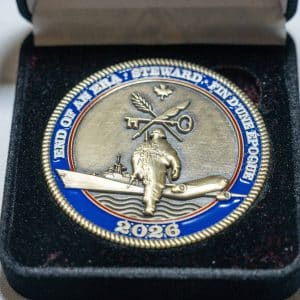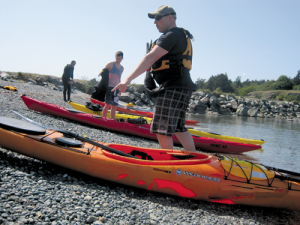
Looming before me is the colossal hull of a warship.
From the vantage of my kayak, which is level with the ocean, the water mirrors the ship in a wrinkled gray reflection.
I crane my neck to see the portholes and then the bow high above.
The ship is berthed at one of the jetties in dockyard at CFB Esquimalt.
Tethered to another jetty is the long black body of a partially submerged submarine bobbing eerily in the dark water.
My destination today is the pebbly shore of Fisgard Lighthouse across the harbour.
I dip my paddle into the water and pull the kayak forward.
I feel the water resist and my uncertainty grow to navigate the distance.
This is only one of a handful of times I have eased my body into the tiny cockpit and clutched the double-ended paddle.
But that novelty will dwindle today as I am taking part in the Pacific Fleet Kayak Club’s introductory course – a two-phase course that starts in a pool and ends on the ocean.
Before launching my kayak into Esquimalt harbour from the Naden boat launch, I and five other rookie kayakers were taught basic safety skills and manoeuvres in the morning at the Naden pool.
Corporal Aaron Miller, lead instructor for the club, started us with a wet exit. We had to self-tip, and while upside-down under the water, unlatch ourselves from the kayak and swim to the surface.
I paddled to the shallow end and steadied my kayak.
With a deep inhale I threw my weight to one side and tipped over.
I kept my eyes tightly closed underwater to guard against the chlorine, and felt for the latch on the rubbery skirt.
I pulled it back and freed myself from the kayak. When I came to the surface, I realized my paddle was not in my hand.
Perfecting this maneuver would have to come later as Cpl Miller moved us on to tackle the partner assisted T-rescue.
In this scenario, one kayaker tips over, resurfaces, and with the help of another kayaker flips the water-filled kayak upright.
The rescuer must grab the bow and pull it across their boat until the front hatch is just about in the rescuer’s lap.
This causes the water trapped in the kayak to fall out of the upside down cockpit.
Then the kayak is flipped upright, and with the two boats close together and the rescuer stabilizing the boat, the submerged kayaker launches their body across the cockpit, kicking their legs and pulling up at the same time.
We were also taught angling our paddles in the water, and trying different correctional paddle strokes.
In the face of high wind or risky currents knowing how to wield my paddle could get me out of a sticky situation quickly.
With the trial run in the pool over, I now find myself rocking precariously on the open ocean.
My arm muscles strain to keep the kayak balanced with each stroke of the paddle.
Once we reach the outskirts of the harbour, Cpl Miller takes the opportunity to teach us contact towing, a safety procedure used in an emergency where one kayaker cannot continue to paddle.
In this situation, another paddler pulls alongside the injured or ill person, and the injured person latches their kayak to the other with their arm.
The towing paddler then paddles them to safety.
As the winds pick up, we are also shown how to create a raft by lacing our kayaks together to form a single floating vessel that is a surprisingly strong defence against stormy conditions.
We break from our raft formation and continue to paddle towards the lighthouse; Cpl Miller navigates his kayak among us, telling stories of the sea life he’s seen: a school of porpoise swimming close to his kayak, seals sunning themselves on the rocks, and underwater creatures visible through shallow, clear waters – anemones, jellyfish, starfish, and spiny crustaceans.
The choppy waves rock my boat.
I straighten my back, relax my hips, and center my weight to counteract the ocean’s sweeping motion.
We approach the tiny cove below the lighthouse; the water is translucent blue-green.
A few metres from shore I hop out of my kayak, wading through the knee-deep water to pull it onto the pebbly beach.
As I lounge on the sun-warmed beach with the others, I watch Cpl Miller demonstrates a self-rescue.
In the center of the cove he angles his kayak to face us.
His chest expands as he takes a deep breath.
Then he plunges into the frigid water by self-tipping his kayak.
In one fluid motion he re-appears, and hauls his dripping body into the kayak, paddle and emergency gear intact.
With that, he motions for us to return to our kayaks.
Back at the clubhouse, we take turns hosing down the salty gear with fresh water.
Without a good rinse, the plastic body of the kayak and any fabric can corrode and deteriorate.
As I dunk my lifejacket into a tub of fresh water, I glance at the setting sun on the horizon.
Past the warships and submarine is the open ocean; a desire to get back on the waves sweeps over me.
Rachel Lallouz
Staff Writer
—
Writer’s Note:
I recommend the course to any beginner who has little to no kayak experience, and to intermediate paddlers who, after the winter months, are looking to brush up their skills. I’d also encourage interested parties to bring their teenage children as completing the course could be useful on a resume for summer camp positions or outdoor recreational activity jobs. Those looking to take on a leadership role in the club should contact Douglas Bell, Club president, who is currently looking for a Vice President. Additionally, the club is introducing stand up paddle boarding, and is looking for and instructor. Contact Ang Lopez at rcnsup@gmail.com.
For those wanting to learn how to slice through the water and brave the underwater wet exit, go to www.pfkc.ca.
